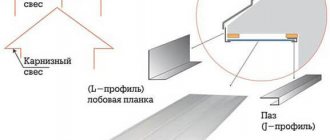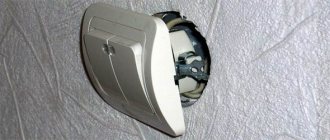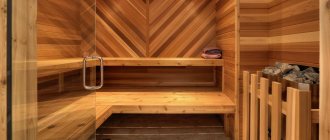At first glance, connecting a three-key switch may cause difficulties and misunderstanding for a person who does not tinker with electricity every day. There's really nothing complicated about it. If you have ever installed a switch, you know that a single has only one output terminal, and a double has two. So, the three-key switch differs only in that it has three output terminals.
This saves a lot of space on the wall, especially when such a switch is connected to a socket in the housing. Agree, it is very convenient to turn on/off the light from one place in different corners (in the toilet, hallway and bathroom) or adjust the brightness of the light with several light bulbs, different lamps or lighting zones in one room/room. Which, by the way, will help save energy by 20-30%.
Design and principle of operation of a three-key switch
The three-keyboard is made in the form of a box from an insulator. It is made of fireproof plastic. The box contains a mechanism responsible for opening and closing contacts. There are also terminals for connecting the cable. It includes 1 central wire and 3 after opening. They go to lamps.
Additionally, there is a fastening mechanism and external elements. They are intended for protection and decoration. This is a plastic frame panel and keys. The parts are simply removed and mounted with latches.
To install lighting for 3 rooms or a chandelier with 3 bulbs, you need to prepare wiring and a hole for mounting a triple switch for three bulbs.
Where are they used?
Modern renovations and design solutions increasingly suggest dividing lighting into different groups.
For example, a room has a complex configuration - niches, ledges, separation by partitions or curtains. Very often now large one-room apartments are divided into zones and made into so-called studios. In this case, a switch with three keys is ideal. By using specially thought-out and mounted zone lighting, you can highlight a work area where there will be a computer desk, a sofa, shelves with books, here the lighting is made brighter. The second zone is the sleeping area, where more subdued light is quite suitable. The third zone is the living room, where there is a coffee table, armchairs, and a TV; here the lighting can be combined.
When else is it advisable to use a three-key household switch?
- If from one point it is necessary to control the lighting of three rooms at once, for example, a corridor, a bathroom and a bathroom, when they are located close to each other.
- In the case of combined lighting in the room - central and spot.
- When in a large room, lighting is provided by a multi-arm chandelier.
- If the room has a multi-level ceiling made of plasterboard sheets.
- When the lighting of a long corridor is divided into three zones.
Areas of use
The three-circuit device has many advantages. The three-key switch looks aesthetically pleasing. Laying electrical conductors to the connection area is extremely simple. The box is placed in a technological niche. When choosing other types of devices, you have to make several holes in the wall.
Three-button switches are used for buildings with non-standard layouts. Switches are used for long corridors and for controlling the lighting of several rooms from one place.
View this post on Instagram
Posted by Electrical Products (@sistemplus) Oct 25, 2018 at 5:26 am PDT
Electrical wiring installation
We will assume that no wires have yet been laid anywhere. Therefore, first of all, lay the three-core power cable VVGng-Ls 3*1.5mm2 in the groove from the panel board to the junction box.
For further disconnection of wires inside, leave a margin of about 10-15cm. You will need it when, for some reason, you experience a short circuit or contact burnout, and you can easily bite out the burnt wires and connect everything again, without cutting or laying a new cable.
The cable cores in the panel board are connected to a separate lighting circuit breaker with a rated current of no more than 10A.
In the junction box, the cable is stripped and the conductors are labeled according to the color and how you connected them in the panel:
L – phase
N – zero
Pe – grounding conductor
By the way, it is advisable to preserve all markings, including the cables themselves, and not just their cores. This will help you in the future, when connecting new lines or repairing this wiring, to quickly figure out which cable comes from where and where it goes.
You can sign with a marker directly on the walls of the box itself.
When marking cores, try to follow the colors approved by the rules.
Blue – zero
Yellow-green – earth
Gray, white, brown, etc. – phase
Selecting a three-key switch
When choosing a three-circuit switch, you should carefully examine it. You should study the physical characteristics and make sure that the wiring diagram is present. A high-quality three-key player has the following characteristics:
- There are no scratches, dents or damage on the case.
- The keys work easily and do not stick.
- Turning on 1 key is accompanied by a click.
- The core and its clamps function properly.
For rooms with high humidity levels, you need to purchase a device that has special protection. Cores with screw and clamp terminals have additional advantages. This will make installation easier and extend the life of the switch.
It is not recommended to buy a device with any defects. Not only uninterrupted lighting, but also safety directly depends on this.
Home use model
In the vast majority of cases, a person uses an excessive number of lighting sources, which is two or more times greater than the real need.
If we stop lighting extra light bulbs, this will save from 10 to 30% of all electricity consumed.
On the other hand, living in conditions of insufficient lighting is uncomfortable, because... and bright and decorative lighting is still necessary.
For this purpose, a track switch is used, which is most often connected to control the main, additional and decorative lighting.
In fact, the key to turn on the main lighting is most often used, the rest are only “occasionally”.
This connection scheme provides, on the one hand, significant energy savings, and on the other hand, allows you to stay in the comfort zone, turning on additional and decorative lighting if necessary.
How to connect a three-key switch with your own hands
Connecting a three-circuit device is extremely simple. To do this correctly, you need to follow many step-by-step steps. The entire connection process is divided into stages:
- connecting the cable to the three-key player;
- connection of wires in the box;
- checking the correct connection and eliminating errors.
Before carrying out the process, it is advisable to study the connection diagram. This measure will help minimize possible mistakes.
Electronic circuit
Let's look at the connection diagram for a three-key switch (Fig. 1).
Fig.1 Switch connection diagram
Six wires come from light sources (from lamps) to the junction box, three of which are connected to each other and then connected to the neutral wire from the switchboard (working zero).
The remaining three wires from the junction box are sent to the device, where they are connected to its outputs.
From here, from the junction box, a phase is connected to the release (it is common to all three light sources).
Now you can see that when one of the contacts in the switch is closed, one or another lamp lights up.
Connection errors
There are problems with connection. It is important to prevent them. Otherwise there is a risk of short circuit.
- A common mistake when connecting a three-key switch is when the switch does not work when the socket is working. The reason lies in the confusion of phase and zero on the socket. The jumper is connected not to the common terminal, but to the phase. The latter turns out to be zero. Use an indicator screwdriver to check the direction of the conductor.
- When replacing the switch block, it is worth checking the voltage on the wires. The rule is not suitable for installation on a new site. Specialists connect the phases to the socket and switch. In this case, there will be 2 power supplies in the block at once. This triple switch circuit will cause a short circuit.
- The light does not light on 2 keys until the third one is turned on. When activated, everything functions properly. The problem is the wire is connected incorrectly. It is directed to the output contact of the last key, but should be directed to the common input. To correct the error, a check with a screwdriver with indicators is required.
- When replacing used blocks with new ones, problems arise. Checking the voltage on the contacts shows all phases. The light comes on on all circuits at once. The switch breaks zero instead of phase. Either the electrician or someone else could have missed. He transferred the wires in the meter or panel to someone else's apartment.
- The contact indicators light up due to the bulbs being screwed into the sockets. The circuit is closed by a filament. After unscrewing the lamps, you need to check the conductors. The glow will disappear if you find a common zero and throw it on the central contact of the new device.
- Connection in the block cannot be made with one key. The method is convenient, but it is erroneous. The load is connected through the socket contacts. An example is a 1.5–2 kW hair dryer.
This is how a tee or extension cord is often connected. However, the switch contacts are not compatible with this magnitude and duration of current. After some time, the voltage in the unit will disappear and a fire may occur.
For more information about connection errors, watch the video:
Kinds
Do not rush to connect a three-key switch until you decide exactly what kind of device you want to see in your apartment. After all, these switching devices come in several types:
- Regular.
- Walkthroughs. They are used in long corridors or on different floors, when at the entrance (at the beginning of the corridor or on the first floor) the lighting is turned on by one switch, and when leaving (at the end of the corridor or on the second floor) another switch is turned off. That is, you don’t need to make your way in the dark and crawl along the wall with your hand to find the button of the switching device.
- With indication. Such light beacons have two options for indicating the status of the device. Or they glow when the lights are off and thereby indicate in a dark room where the switching device is located. Or, on the contrary, the beacons light up when the keys are turned on, thereby making it clear where exactly the light is currently turned on.
- Three-key switch with socket. They are most often used in rooms where a toilet, bathroom and corridor are located nearby.
Combined triple instruments
Switch with built-in socket
The triple switch, combined with a socket, is a combined version. It is suitable only for installation in certain places where it will be convenient to control the lamp and use the socket. The most suitable place for this is a dressing table in the bathroom, equipped if you need to connect a hairdryer or curling iron while simultaneously turning on the lighting.
You can install and connect such a module in its usual place – on the wall.
However, in this case the provisions of the current standards are violated. According to the PUE, the height of the switches must correspond to the level of a person’s forearm. The same requirements stipulate that the outlet should be located at a level of no more than one meter from the floor. The inconveniences of such an arrangement also include difficulties in including it in the existing wiring. To connect the combined device, you will need to modify the wiring diagram or run separate wires to it, which is not entirely aesthetically pleasing.
Preparation
Here we come to the instructions for connecting the switch. Why just a switch? The thing is that, in essence, the installation of a two-key switch is not much different from a regular one-key switch. There is nothing complicated in this process, because you just need to follow safety precautions and follow the necessary steps.
First you need to disassemble the switch. To do this, you must first remove the keys. It's easy to do and doesn't require much effort. You need to pull the key towards you, and if this does not work, then take a simple screwdriver and slightly pry the key from the side with it.
You can already see the insides of the switch, which means you need to remove the decorative backing. It is located around the keys, and is removed only after the keys have already been removed. Now we have a bare frame in our hands, which is ready for installation.
Now, when it comes time to work with contacts, make sure that the voltage is turned off to the entire room, or to this particular area. To do this, you can use a simple syndicate screwdriver.
Manufacturing companies
Often the choice of a particular switch with a socket is determined by the attractiveness of the design. For example, the Spanish company produces antique-style models. German products are distinguished by modern, sophisticated design. French electrics are successfully integrated into the surrounding interior: both vertical and horizontal modifications are made. Perhaps the widest selection of products is presented. The product line of this Swiss company also includes products with LED backlighting.
Among Russian manufacturers, Kuntsevo-Electro can be distinguished. The company produces several models of three-key switches:
- BELLA BKVR-039 (there is a socket without a grounding contact);
- BELLA BKVR-212 (with indicator light);
- BELLA BKVR-036 (the model is equipped with a European socket and protective curtains).
Combined unit Bella BKVR-033 and BKVR-054
The specified switches operate in 220 V networks with a rated current of 10 A. Models are also produced in Russia for a rated current of 16 A with grounding. For example, NPO Elektrotekhnika produces models BZVRzk-S and BZVRzksh-S.
Flaws
1
If your light bulb burns out and needs to be replaced, with such a scheme it is not immediately possible to understand whether the light is on or off.
It will be unpleasant when, when replacing, the lamp may simply explode in front of your eyes. In this case, the easiest and most reliable way is to turn off the automatic lighting in the panel.
2
If your wiring goes under the ceiling, you will have to lower the wire from there to each switch, and then lift it back up. The best option here is to use pulse relays.
And if you don’t want to lay wires and ditch walls at all, is it possible to install pass-through switches in this case? It’s possible, but all costs will be around 800-1000 rubles. How to do this, read the article “Wireless pass-through switch.”
Sources - https://cable.ru, Kabel.RF











